

ggplot(data_air_nona, aes(x = Month, y = Ozone, color = Month)) +
#VIEW MODE STRETCH DOT BY DOT CODE#
It makes the code more readable by breaking it. The + sign means you want R to keep reading the code.Inside the aes() argument, you add the x-axis and y-axis.You pass the dataset data_air_nona to ggplot boxplot.Add the geometric object of R boxplot().

box_plot: You store the graph into the variable box_plot It is helpful for further use or avoid too complex line of codes.# Store the graphīox_plot <- ggplot(data_air_nona, aes(x = Month, y = Ozone)) Let’s plot the basic R boxplot() with the distribution of ozone by month. # $ day_cat Begin, Begin, Begin, Begin, Begin, Begin, Begin, Begi. # $ Month May, May, May, May, May, May, May, May, May, May, May. Mutate(Month = factor(Month, order = TRUE, labels = c("May", "June", "July", "August", "September")),ĭay_cat = factor(ifelse(Day < 10, "Begin", ifelse(Day < 20, "Middle", "End"))))Ī good practice is to check the structure of the data with the function glimpse(). Step 4: Create a new categorical variable dividing the month with three level: begin, middle and end.Īll these steps are done with dplyr and the pipeline operator %>%.Numerical variableīefore you start to create your first boxplot() in R, you need to manipulate the data as follow: This dataset measures the airquality of New York from May to September 1973. We will use the airquality dataset to introduce boxplot() in R with ggplot. You can use the geometric object geom_boxplot() from ggplot2 library to draw a boxplot() in R. Boxplot() in R helps to visualize the distribution of the data by quartile and detect the presence of outliers.


 0 kommentar(er)
0 kommentar(er)
